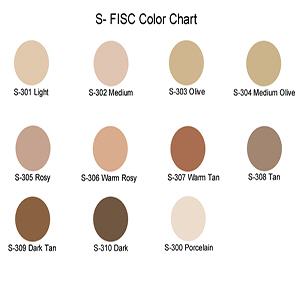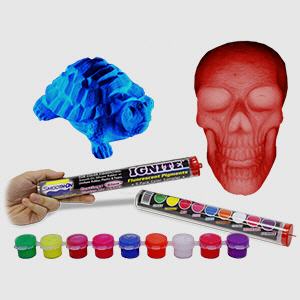- 3D Printers and accessoires
- Modeling
- Molding & Casting
- Tin Silicones
- Platinum Silicones
- Dragon Skin™ Series
- Ecoflex™ Series
- Equinox™ Series
- Mold Star™ Series
- Rebound ™ Series
- Smooth-Sil™ Series
- SORTA-Clear™ Series
- Body Double™ Series
- Psycho Paint™
- Platsil Gel & Deadener
- Rubber Glass ™
- Encapso® K
- Solaris™
- Soma Foama™
- EZ-Brush™ Vac Bag Silicone
- EZ-Spray Platinum Silicones
- Silicone Additives
- PU-Rubbers
- Alginate
- PU-Resins
- PU Foam
- Epoxy Resins
- Polyester Resins
- Gypsum & Cement
- Latex
- Mask Making Latex
- Mold Making Latex
- FormX Elastica Latex Rubber
- Monstermakers Foam Latex
- Monstermakers Mask making latex RD-407
- Monstermakers additives & Components
- Holden's Coating/Dipping Latex
- Holden's Body Latex™ - Brushable
- Holden's Mold Making Latex HX-80™
- Holden's Mold Making Latex High Viscosity HX-974™
- Holden's Mask Making Latex - Pourable HX-407™
- Holden's Mask Making Latex - Brushable HX-807™
- Holden's Cosmetic Latex™
- Holden's Frisket Mask Latex
- Holden's HX-Injection Medium™
- Latex Accessories
- Latex Pigments
- Latex Paint
- Latex Thickener
- AcrylCast
- Prince August
- Concrete Mixtures
- Jesmonite Acryl System
- Buddy Rhodes™ Concrete Products
- Seal and Release
- Additives
- Pigments
- Jesmonite Liquid Pigments
- Pure Pigment Powder
- Ultra Fine Pigment Powder
- Silc Pig™ pigments for silicone
- Glow Worm™ Fluorescent Pigments
- Cryptolyte™ Glow in the Dark
- SilcPig™ Electric fluorescent for silicone
- Siltone Pigments for silicone
- SilTone Kits
- FuseFX Silicone Coloring System
- S.A.M Silicone Coloring System
- Key Pigments for Silicone
- Kryolan Flock Fiber
- Latex Pigments
- Polyester Pigment
- UVO™ - PU-pigments - UV-Resistant
- SO-Strong - PU-pigments
- Ignite™ fluorescent PU-pigments
- Real Metal Powders
- Faux Metal Powders
- Cast Magic™ Powders
- Paints
- Maker Pro Paint™
- Maker Pro Paint™ Fluorescent
- Maker Pro Paint™ Metallics
- Maker Pro Paint Additive
- Vallejo Acrylic Paints
- Vallejo Metal Color
- Vallejo Acrylic Mud
- Vallejo Primers and Laquer
- Psycho Paint™
- MM Latex Paint
- MM Latex Paint Base
- FFX LY-series silicone paints
- FFX F-series silicone paints
- FFX M-series silicone paints
- jesmonite paint
- Fillers and Finishing
- Solvents & Thinners
- Adhesives
- Tools
- Equipment
- Special Make-Up
- Cannom grease paint
- Skin Illustrator palettes
- Skin Illustrator Liquid
- Fleshtone 60ml
- Fleshtone 120ml
- Dark Fleshtone 60ml
- Dark Fleshtone 120ml
- FX 60ml
- FX 120ml
- FX 240ml
- Complexion 60ml
- Complexion 120ml
- Alchemy 60ml
- Alchemy 120ml
- Grunge 60ml
- Grunge 120ml
- Grunge 240ml
- Mardi Gras 60ml
- Mardi Gras 120ml
- Necromania 60ml
- Mekash Colors 60ml
- Clear Gloss 60ml & 120ml
- Glo-Worm 60ml & 120ml
- Tattoo Classic 60ml & 120ml
- Sunburn
- Alphabetical all
- Skin Illustrator Liquid Concentrates
- Fleshtone liquid Concentrate 60ml
- Dark Fleshtone liquid Concentrate 60ml
- FX liquid Concentrate 60ml
- FX liquid Concentrate 120ml
- Alchemy liquid Concentrate 60ml
- Grunge liquid Concentrate 60ml
- Mardi Gras liquid Concentrate 60 ml
- Necromania liquid Concentrate 60ml
- Necromania liquid Concentrate 120ml
- Concentrate Alphabetical
- Skin Illustrator Singles
- Skin Illustrator Glazing Gels
- Skin Illustrator Glazing Spray
- Skin Illustrator Mouth FX
- AlliedFX (Blue Bird)
- RipperFX Palettes
- Stacolor Palettes
- Maqpro Farde Palettes
- Tattoo
- PAX Paints Thomas Suprenant
- MaqPro Make-Up Mixer
- MaqPro Creamy
- MaqPro Bruise Gel
- Old Age Stipple
- Holden's Cosmetic Latex™
- Brushes Make-Up
- Stamps & Molds
- Head Armatures
- Sponges and Applicators
- FormX Tools
- Kryolan Make-Up
- Special effects
- Prostetic Materials
- Help me choose
- Literature
Dragon Skin™ 10 Fast /0,9 kg
Dragon Skin™ 10 FAST

Dragon Skin™ silicones are high performance platinum cure liquid silicone compounds that are used for a variety of applications ranging from creating skin effects and other movie special effects to making production molds for casting a variety of materials. Because of the superior physical properties and flexibility of Dragon Skin™ rubbers, they are also used for medical prosthetics and cushioning applications. Dragon Skin™ rubbers are also used for a variety of industrial applications and have a service temperature range of a constant (-53°C to +232°C)
Dragon Skin™ 10 FAST Working time 8 mintutes - Cure Time 75 minutes - Shore A10
Features
Time Tested, Versatile Special Effects Material – Soft, super-strong and stretchy, Dragon Skin™ 10 is used around the world to make spectacular skin and creature effects. An infinite number of color effects can be achieved by adding Silc Pig™ silicone pigments or Cast Magic™ effects powders. Cured rubber can also be painted with the Psycho Paint™ system. Cured material is skin safe and certified by an independent laboratory.
Easy To Use – Dragon Skin™ silicones are mixed 1A:1B by weight or volume. Liquid rubber can be thinned with Silicone Thinner™ or thickened with THI-VEX™. Rubber cures at room temperature 23°C with negligible shrinkage. Vacuum degassing is recommended to minimize air bubbles in cured rubber.
Dragon Skin™ 10 silicones are Flame Rated to UL-94 HB specification and they meet the B1 classification for the GB 8624-2012 Fire Test to Building Material and Products (does not include ‘NV’ formulas)
Certified Skin Safe - Cured Dragon Skin™ Series is skin safe and is certified by an independent laboratory. OECD TG 439 certification. No animals were used in testing.
Instructions
Safety – Use in a properly ventilated area (“room size” ventilation). Wear safety glasses, long sleeves and rubber gloves to minimize contamination risk. Wear vinyl gloves only. Latex gloves will inhibit the cure of the rubber.
Store and use material at room temperature 23°C. Warmer temperatures will drastically reduce working time and cure time. Storing material at warmer temperatures will also reduce the usable shelf life of unused material. These products have a limited shelf life and should be used as soon as possible.
Cure Inhibition – Addition-cure silicone rubber may be inhibited by certain contaminants in or on the pattern to be molded resulting in tackiness at the pattern interface or a total lack of cure throughout the mold. Latex, tin-cure silicone, sulfur clays, certain wood surfaces, newly cast polyester, epoxy or urethane rubber may cause inhibition. If compatibility between the rubber and the surface is a concern, a small-scale test is recommended. Apply a small amount of rubber onto a non-critical area of the pattern. Inhibition has occurred if the rubber is gummy or uncured after the recommended cure time has passed.
To prevent inhibition, one or more coatings of a clear acrylic lacquer applied to the model surface is usually effective. Allow any sealer to thoroughly dry before applying rubber. Note: Even with a sealer, platinum silicones will not work with modeling clays containing heavy amounts of sulfur. Do a small scale test for compatibility before using on your project.
Because no two applications are quite the same, a small test application to determine suitability for your project is recommended if performance of this material is in question.
Applying A Release Agent - Although not usually necessary, a release agent will make demolding easier when pouring into or over most surfaces. Ease Release™ 200 is a proven release agent for making molds with silicone rubber. Mann Ease Release™ products are available from form x
IMPORTANT: To ensure thorough coverage, lightly brush the release agent with a soft brush over all surfaces of the model. Follow with a light mist coating and let the release agent dry for 30 minutes.
If there is any question about the effectiveness of a sealer/release agent combination, a small-scale test should be made on an identical surface for trial.
Measuring and Mixing - Before you begin, pre-mix Part B thoroughly. After dispensing required amounts of Parts A and B into mixing container (1A:1B by volume or weight), mix thoroughly for 3 minutes making sure that you scrape the sides and bottom of the mixing container several times. After mixing parts A and B, vacuum degassing is recommended to eliminate any entrapped air. Vacuum material for 2-3 minutes ( 0,98 bar), making sure that you leave enough room in container for product volume expansion.
For best results, pour your mixture in a single spot at the lowest point of the containment field. Let the rubber seek its level up and over the model. A uniform flow will help minimize entrapped air. The liquid rubber should level off at least 1.3 cm over the highest point of the model surface.
Curing / Post Curing - Allow rubber to cure as prescribed at room temperature 23°C before demolding. Do not cure rubber where temperature is less than 18°C. Optional: Post curing the mold will aid in quickly attaining maximum physical and performance properties. After curing at room temperature, expose the rubber to 80°C for 2 hours and 100°C for one hour. Allow mold to cool to room temperature before using.
If Using As A Mold - When first cast, silicone rubber molds exhibit natural release characteristics. Depending on what is being cast into the mold, mold lubricity may be depleted over time and parts will begin to stick. No release agent is necessary when casting wax or gypsum. Applying a release agent such as Ease Release™ 200 available from form x prior to casting polyurethane, polyester and epoxy resins is recommended to prevent mold degradation.
Thickening Dragon Skin™ Silicones - THI-VEX™ is made especially for thickening Smooth-On’s silicones for vertical surface application (making brush-on molds). Different viscosities can be attained by varying the amount of THI-VEX™.
Thinning Dragon Skin™ Silicones - Smooth-On’s Silicone Thinner™ will lower the viscosity of Dragon Skin™ for easier pouring and vacuum degassing. A disadvantage is that ultimate tear and tensile are reduced in proportion to the amount of Silicone Thinner™ added. It is not recommended to exceed 10% by weight of total system (A+B).
Mold Performance & Storage - The physical life of the mold depends on how you use it (materials cast, frequency, etc.). Casting abrasive materials such as concrete can quickly erode mold detail, while casting non-abrasive materials (wax) will not affect mold detail. Before storing, the mold should be cleaned with a soap solution and wiped fully dry. Two part (or more) molds should be assembled. Molds should be stored on a level surface in a cool, dry environment.
Dragon Skin Can be used with:
Guide
Let us help you find your way.
The list below may help you find what you are looking for via an alternative path.






